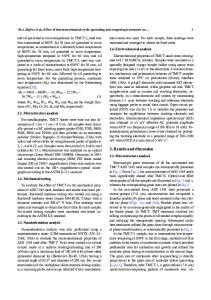Influence of thermomechanical treatments on the microstructure and mechanical properties of HSLA-100 steel plates
- PDF / 3,484,129 Bytes
- 13 Pages / 612 x 792 pts (letter) Page_size
- 103 Downloads / 477 Views
bon copper-bearing steels (i.e., ASTM A 710, HSLA-80, HSLA-100, etc.) have been developed over the last two decades in order to replace traditionally used quenched and tempered HY steels.[1–10] Copper is used as the main strengthening element in these steels, unlike HY steels, where carbon is used for martensitic strengthening.[11] These copper-bearing steels are easy to weld and require no costly preheating or postweld heat treatments.[12] These steels are primarily intended for use in the construction of hulls for naval warships and submarines, but can be also recommended for making components of engineering bodies like mining and dredging equipment, offshore drilling platforms, and heavy-duty trucks and bridges.[13,14] High strength, good impact toughness, and easy weldability are the major criteria for these steels. After successful development of HSLA-80 steel in the early 1980s, the United States Navy initiated a research and development program on an HSLA-100 steel with superior strength (yield strength (YS) of 692 MPa) and impact toughness (81 J at ⫺85 ⬚C). The steel has a nominal composition of 0.06 pct C, 1 pct Mn, 0.02 pct P, 0.006 pct S, 0.4 pct Si, 1.6 pct Cu, 3.50 pct Ni, 0.6 pct Cr, 0.6 pct Mo, 0.03 pct V, and 0.04 pct Nb. Few trial heats were made in this regard in the late 1980s and S.K. DHUA, Principal Research Manager, and D. MUKERJEE, Deputy General Manager, are with the Research and Development Centre for Iron and Steel, Steel Authority of India Limited, Ranchi - 834002, India. Contact e-mail: [email protected] D.S. SARMA, Professor, is with the Department of Metallurgical Engineering, Banaras Hindu University, Varanasi– 221005, India. Manuscript submitted June 14, 2001. METALLURGICAL AND MATERIALS TRANSACTIONS A
early 1990s.[13] Since then, there have been efforts to obtain a critical understanding of its structure-property relationships. Although several studies have been performed to understand the tempering behavior of HSLA-100 steel,[6,15–20] very few attempts have been made to study the influence of thermomechanical treatment (TMT) on the structure and properties of this steel.[21,22,23] The benefits of TMTs in achieving a desired microstructure tailored to the specific mechanical properties of HSLA steel is well known. By adopting the TMT techniques of controlled rolling and accelerated cooling, it is possible to obtain a fine-grained microstructure with an excellent combination of strength and impact toughness.[24–32] The process of online direct quenching has also been developed as a part of thermomechanically controlled process and is presently being applied to produce high-strength steel plates requiring good toughness and weldability. There are several benefits of direct quenching over the conventional reheat quenching process. First, it reduces the production cost by eliminating the reheating and quenching steps. Second, a reasonable combination of strength and toughness can be achieved without affecting weldability.[33,34] Third, it could save costly alloying elements by providing t
Data Loading...











